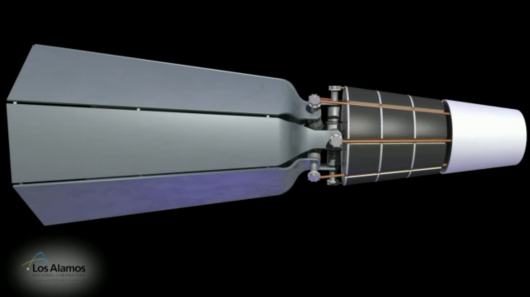Low Powered KiloPower Nuclear Reactors Being Designed For Space Missions
I have mentioned thermionic power generators that use plutonium-238 to provide power for space probes in past posts. Recently there have been some problems with obtaining sufficient Pu-238 for NASA deep space missions. Nuclear propulsion systems for large spacecraft have also been proposed for decades. With the recent expansion of private space industry, interest in nuclear propulsion has increased. However critics have said that using nuclear power for space propulsion would be too difficult, would take too long and would be too expensive.
Jeff Bezos, whose fortune comes from his stake in the Amazon company, has a space exploration business called Blue Origin. He recently said, "I think NASA should work on a space-rated nuclear reactor. If you had a nuclear reactor in space—especially if you want to go anywhere beyond Mars—you really need nuclear power. Solar power just gets progressively difficult as you get further way from the sun. And that’s a completely doable thing to have a safe, space-qualified nuclear reactor."
The Los Alamos National Laboratory, NASA and Department of Energy divisions have been working on the idea of nuclear power for use in space vehicles lately. They are focusing on a new generation of small fission reactors that can generation from a hundred watts to a hundred kilowatts of energy. These small reactors are known as KiloPower reactors. They use well know principles in simplified designs with inherent safety features. They are designed to be able to handle the stress of launch as well as operational transients. The feasibility of this approach was shown in 2003 and it is hoped that it will be possible to have a full-scale demonstration in 2017.
In order to have a reactor operate stably, you want to maintain a steady level of neutron generation. If the reactor starts generating more and more neutrons, the nuclear reactions will increase and the temperature will rise. If the reactor gets hot enough, it can melt down. On the other hand, if the number of neutrons goes down, the nuclear reaction will diminish and less power will be generated. Terrestrial power reactors have sophisticated and complex control systems of moderator rods and cooling fluids that can control the neutron generation and reactor temperatures.
It is also possible to design reactors in such a way that as the temperature goes up, the power generation goes down automatically and as temperature goes down, power generation goes up. Like the thermostat in a house, this results in maintaining a constant level of operation. The new generation of KiloPower reactors is designed to exploit this type of control.
The KiloPower design is based on a solid uranium-molybdenum cylindrical core. Heat pipes carry heat to Stirling engines which convert the heat into electricity. The system is designed to be able to recover from large differences between the core output and the conversion module. Various components were developed that would simulate the operation of different parts of the KiloPower system. In one test, a quarter of the thermal energy conversion system was shut down suddenly and the system was able to automatically recover from the mismatch and keep operating. So far, the mechanical tests of components have matched the theoretical results of computer simulations.
There will be a final test in late 2017 where a live core will be connected via sodium heat pipes to sterling engines. Beryllium oxide rings will surround the core to act as neutron reflectors. The whole assembly will sit atop a test stand in a vacuum chamber. The system will be powered up and, hopefully, generate two hundred and fifty watts of power. The test will assess the startup, operation, stability and shut down of the system.
If all goes well, it will still take several years for final testing, final design selection and the construction of a fully functional prototype KiloPower system for use in space. The first use being considered for the new KiloPower system is use for a manned Martian expedition. The system will generate forty watts of power that can be used to provided water for the crew and to create fuel for rovers. When the mission ends, the KiloPower system can create rocket fuel to carry the crew back to Martian orbit from the surface.
If the development of KiloPower reactors is successful, a new generation of MegaPower reactors will be next. These reactors will used on Earth to provide a few megawatts of electricity to remote locations. An air based system will be used for power conversion and heat dissipation.
Artist's concept of a KiloPower system:
